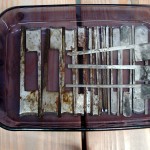 “The larger project” that I made shelf brackets for involves the collection of hollows and rounds molding planes I acquired last fall. This project wants at least a couple of them to be tuned up for peak performance. Now that our winter weather has brought dry air, the planes are much easier to disassemble and adjust. A couple of hammer taps on the trailing end knocks the blades loose easily. In the muggy fall, they needed a lot more beating to get the parts to move. So…. since it’s so easy, let’s clean all of them.
“The larger project” that I made shelf brackets for involves the collection of hollows and rounds molding planes I acquired last fall. This project wants at least a couple of them to be tuned up for peak performance. Now that our winter weather has brought dry air, the planes are much easier to disassemble and adjust. A couple of hammer taps on the trailing end knocks the blades loose easily. In the muggy fall, they needed a lot more beating to get the parts to move. So…. since it’s so easy, let’s clean all of them.
One thing is very obvious. The previous owner had a lot more love for the rounds than the hollows.
A few hours in my favorite non-toxic rust remover, white vinegar, will clean them up nicely. The wooden bodies and wedges are so clean that wiping down with mineral spirits is all they need.
P.S. For anyone considering using vinegar for rust removal, keep it away from your workbench. Vinegar does a good job of “ebonizing” the fir my bench is made of.
Hello Bob,
I’m looking forward to see the nicely cleaned and tuned planes all lined up.
Two questions about the vinegar: Is it a problem that the “good” metal is also affected by the acid? What’s the concentration of your vinegar?
Thank you Tobias
Hi Tobias,
The vinegar has minimal effect on the good metal. I have seen it darken the surface color of some metals, most noticeable with files which turn from a medium gray to a quite dark gray. There was almost no darkening of these plane blades. The photo shows blotchy dark areas on some of the blades, maybe from a previous bath of some sort. The vinegar didn’t change these areas. They’re no darker, nor no brighter. Areas of red rust are now dark gray like those blotches.
This vinegar is straight from the grocery shelf, “Distilled White Vinegar” 5% acidity. the same stuff we use on salads. Cheap, effective, readily available and non-toxic.
So are they even perfectly round anymore? If so, are they matched to some standard progression radii? i.e. are you going to resharpen them freehand or turn some rods and tubes to match and use a scarysharp/sandpaper approach to clean up their edges?
Most of the irons still have the right profiles. The profiles are governed by the wooden plane bodies. Any resharpening must match the body. The standard sizing of hollows and rounds is by the width of a 60 degree arc. The smallest is 1/8 inch wide. They generally increase by about 1/8 inch in width until the widest of 1.5 inches. I say “about” because a set is actually 18 planes. A complete set of all hollows and all rounds is 36 planes.
I’ll sharpen freehand using slip stones with curved edges. I have an orange India stone for course and a collection of Arkansas stones for fine and extra fine. Those 3 grades are enough to get to surgically sharp. I switched from scary sharp sandpaper to Arkansas stones last year when I found some good prices on the rapidly dwindling supply a extra fine translucent stones. These will last my lifetime and yours.
Speaking of surgically sharp, I was quickly wiping the vinegar off the irons this morning and lightly grazed a thumb knuckle. Ouch! Dang! Pass the pepper.